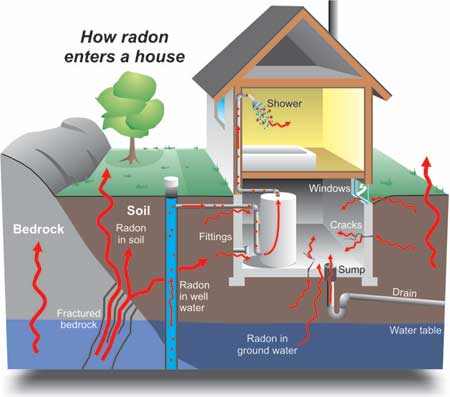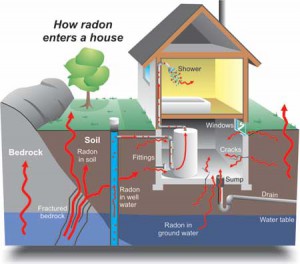
According to the EPA, radon is the leading cause of lung cancer in non-smokers in the United States and can be linked to up to 20,000 lung cancer deaths a year.
Although many homeowners have likely heard of radon, they do not necessarily know what it is or how it can harm their family.
 Here’s what you need to know as a Louisville homeowner:
Here’s what you need to know as a Louisville homeowner:
- This radioactive particle is found the air and can cause lung cancer in those exposed to large amounts. Radon is produced by the natural decay of uranium in the soil but this decay can be fixed and homes made safe from radon.
- At home tests are available for testing your home’s radon levels. Generally, these accumulate in the basement, nearest the ground where decaying uranium resides. The average concentration of radon in a home in the United States is 1.3 pCi/L. Radon concentrations between 2 and 4 pCi/L should consider fixing their home to protect against exposure to radon. For levels above 4 pCi/L the EPA strongly recommends action to be taken.
- Contractors are available to test and fix your home. These people are experts in mitigating the risks of radon and ensuring your home is safe.
Contractors can be hired to inspect your home, especially rooms below ground level and those directly above ground level, for radon levels deemed unsafe. If your home does have higher than average radon levels there are a number of options.
Options for Homes with High Radon Levels
As stated above, the EPA has set a maximum radon level of 4 pCi/L. Many homeowners take this to mean that anything below this level is ?safe?.; however, any levels between 2 and 4 pCi/L should still be considered dangerous and steps should be taken to reduce them. A local mitigation company will be able to explain the best option for dealing with radon in your home but generally there are three different solutions depending on the structure of our home.
- For homes with basements, one of four types of suction can be used to reduce radon. Essentially, this process uses pipes directly in the earth below the basement slab and fans. The fans create suction below the slab and suck the radon up through the pipe. The open end of the pipe generally leads to an attic or outside the home where the radon is quickly diluted to safer levels.
- Homes with a crawl space generally will use a thick plastic sheet layer over the earth. Underneath this sheet, a pipe and fan, much like that mentioned above, suck the radon out from the space between the ground and the plastic sheet and ventilate it to the outside. In some cases, ventilation of the space without a plastic sheet can also be used to reduce radon.
- Any home, no matter the footings can benefit from sealing cracks in the foundation but this should be done in conjunction with other solutions to ensure the radon levels are reduced enough.
- Ventilation of any space that may have excess radon is always a good idea. In lower levels of the home be sure to open windows periodically, run fans to move the air up and out and keep track of radon levels.
The health risks associated with radon mean that all steps necessary should be taken to reduce exposure. Any of the above solutions can be used in conjunction with one another to ensure maximum diffusion. If you have radon accumulation in your home, contact a professional to ensure the correct steps are taken to reduce its presence and protect your family.
For more information about radon visit the EPA website at http://www.epa.gov/radon/index.html. There you will find information about radon levels in your area, where to find testing kits and the more about solutions to radon in your home.
Special thanks to Kylene Golubski, President of Inspect-It 1st Property Inspection for the information in this article.



